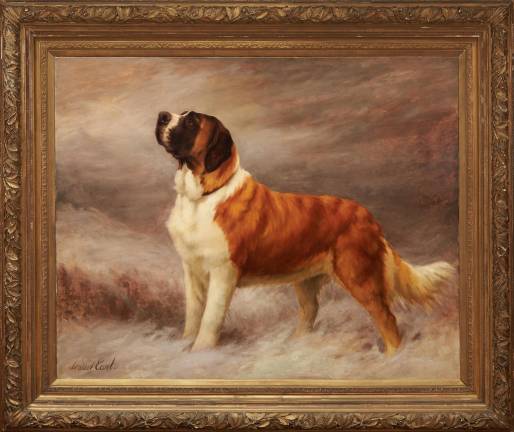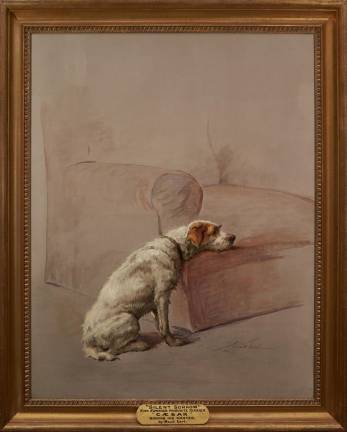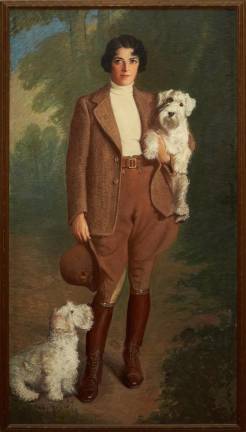Fans of PBS’s “Victoria” will no doubt have noticed the British monarch’s infatuation with Dash, a Cavalier King Charles spaniel. The Queen and her husband Prince Albert were famously dog friendly, welcoming a riot of breeds—the Skye terrier Islay, the German greyhound Eos, the Pekingese Looty and more— into the royal fold.
Victoria was not only an established breeder of canines, but also a patron of the arts, commissioning portraits of her dogs for posterity. One artist tapped to paint the royal pooches was British-born Maud Earl (1864-1943), the greatest female dog portraitist of her time and the first woman to paint the dogs of the British monarchy.
The AKC (American Kennel Club) Museum of the Dog, which returned to Manhattan in February from St. Louis, owns some 80 works by Earl, almost all on view on two floors in this very engaging dog-days-of-summer show, “Women and Dogs in Art in the Early 20th Century.”
It’s an exhibit that pays tribute to the unsung women who painted, sculpted and etched man’s best friend, with a hat-tip to the breeders (“fanciers” like Victoria and the Duchess of Newcastle), the dog-show exhibitors and the entrepreneurs.
The art here defies expectations. It’s not kitschy, but mostly highbrow and serious. Featured females include Lillian Cheviot, Lucy Waller, Mildred Megargee, Diana Thorne, Lucy Dawson, Marguerite Kirmse, Christine Merrill, Kay Finch and Laura Gardin Fraser, the latter the first woman to design a coin, the Alabama Centennial half-dollar, for the U.S. Treasury.
Mastering the Breeds
It’s Earl, however, dubbed the “First Lady of Dog Painting” in a recent article in the AKC Gazette, who immediately captures our attention and moves us with her sensitive canine portraits. Her purebreds have a beauty and artfulness lacking in the more anatomically precise, “utilitarian” works of artists like Lucy Waller, a Victorian who painted “to document champion dogs. You’ll find that there are people who are artists and people who are just doing portraits. They judge the paintings the way they judge the dogs,” Alan Fausel, Executive Director of The AKC Museum of the Dog, said on a private tour.
To that end, the canines of Waller and Mildred Megargee, for instance, are presented in profile as if they are competing at a dog show. Such prosaic painters “love feet, they don’t like these,” Fausel said, pointing to Earl’s more sophisticated “Two Pointers on Point in a Field” (1905), with tall, breezy grasses obscuring the dogs’ paws. Maud was able to add expression through the eyes of her canines. She layered her paints and used thin glazes to create dog coats with texture and shine.
In the book “Best in Show: The Dog in Art from the Renaissance to Today,” dealer William Secord writes that Earl “always captured the individual type and character of the dog she depicted.” She completed her first canine painting in 1880 and spent the next 60 years mastering the breeds.
Capturing the Human-Canine Bond
Her virtuosity begins here with a memorial, “Silent Sorrow” (1910), a painting of King Edward VII’s best friend, Caesar, resting his head on the late monarch’s armchair. Edward was Queen Victoria’s son and inherited her love of dogs.
“When Edward died, Caesar was allowed in the funeral procession, ahead of nine heads of state,” Fausel said of the wire fox terrier. Pointing to the symbolically missing parts of the chair, he added: “You can sense the fading into the distance of the smells and memory of his master.” The poignant piece is about loss, but also pays homage to the human-canine bond.
An etching of Caesar by Earl, “I Belong to the King” (1910), is also part of the show and can be seen on the second floor, where the female-centric display continues in the middle of the exhibition space. Note the open-storage racks that slide in and out for a look at the very distinctive photogravure prints of Maud’s work created for two portfolios, “Terriers and Toys” (1902) and “British Hounds and Gun Dogs” (1903).
“She painted almost all the famous dogs of the day and then had them photogravured in limited portfolios of 500,” Fausel said.
“Terriers and Toys,” on view in a vitrine, was sponsored by King Edward VII and is a testament to Earl’s lofty patronage and can-do entrepreneurial spirit. The print portfolios, she knew, would allow her work to be seen by the general public.
There are some outliers here. Case in point: “Portrait of Bea Godsol” (1930), with Sealyham terriers, by John Dwight Bridge (yes, a man in this sea of accomplished women). Godsol was not an artist, but a player in the dog-show world. She was a fancier, an exhibitor and an all-round judge, who once said, “All dogs have faults. The great ones carry them well.”
However, it is Earl’s soft, brushy depiction of a Saint Bernard, “I Hear a Voice” (1896), that leads the pack. Fausel pronounced the painting “the AKC’s pride and joy.” It situates a Saint Bernard in an Alpine setting, on the alert for a traveler in distress. But this top dog, Champion Frandley Stephanie, never set foot in the Alps. It’s just an imagined scene by an imaginative painter.
IF YOU GO
What: “Women and Dogs in Art in the Early 20th Century”
Where: The AKC Museum of the Dog, 101 Park Avenue (at East 40th St) museumofthedog.org
When: Through September 29


